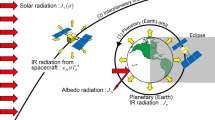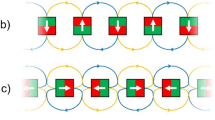Numerical assessment of the thermal safety of inductive power transfer systems imposes significant computational costs. This report proposes a method with significantly reduced computational costs. The first step requires calculation of heating for two arbitrary sets of values for the properties of the inductive power transfer system. A linear approximation for the power dissipation-temperature relationship is obtained using these two points. The thermally optimal characteristics of the system can then be obtained by substituting the values of the required temperature into the resulting linear equation. This method is shown to provide sufficient accuracy for it to be used in design procedures for low-frequency inductive power transfer systems for implantable devices.
Similar content being viewed by others
References
Haerinia, M. and Shadid, R., “Wireless power transfer approaches for medical implants: A review,” Signals, 1, No. 2, 209-229 (2020).
Khan, R. K., Pavuluri, S. K., Cummins, G., and Desmulliez, M. P. Y., “wireless power transfer techniques for implantable medical devices: A review,” Sensors, 20, 1-56 (2020).
Maniar, S., Kondareddy, S., and Topkara, V. K., “Left ventricular assist device-related infections: Past, present and future,” Expert Rev. Med. Devices, 8, No. 5, 627-634 (2011).
Mehta, S. M., Pae, W. E., Rosenberg, G., Snyder, A. J., Weiss, W. J., Lewis, J. P., Frank, D. J., Thompson, J. J., and Pierce, W. S., “The LionHeart LVD-2000: A completely implanted left ventricular assist device for chronic circulatory support,” Ann. Thorac. Surg., 71, No. 3, S156-S161 (2001).
Lin, W.-Yi., Lin, Ch.-P., Hsu, Ch.-H., Lee, Yi.-H., Lin, Yi-T., Hsu, M.-Ch., and Shao, Yu.-Yu., “Right or left? Side selection for a totally implantable vascular access device: A randomised observational study,” Br. J. Cancer, 117, 932-937 (2017).
Au, Sh., McCormick, D., Lever, N., and Budgett, D., “Thermal evaluation of a hermetic transcutaneous power transfer system to power mechanical circulatory support devices in destination therapy,” Artif. Organs, 4, No. 9, 955-967 (2020).
Knecht, O. and Kolar, J., “Impact of transcutaneous power transfer on the electric field and specific absorption rate in the human tissue,” IECON 2015 – 41st Annual Conference of the IEEE Industrial Electronics Society, 004977-004983 (2015).
ISO 14708-1:2000, Implants for surgery – Active implantable medical devices – Part 1: General requirements for safety, marking and information to be provided by the manufacturer (2014).
Danilov, A. A., Mindubaev, E. A., and Selishchev, S. V., “Methods for compensation of coil misalignment in systems for inductive transcutaneous power transfer to implanted medical devices,” Biomed. Eng., 51, 56-60 (2017).
Ryabchenko, E. V., Mindubaev, E. A., and Danilov, A. A., “The effect of misalignment of induction coils on tissue heating during wireless transcutaneous energy transfer,” Biomed. Eng., 54, 203-207 (2020).
Wissler, E. H., “Pennes’ 1948 paper revisited,” J. Appl. Physiol., 85, 35-41 (1985).
Author information
Authors and Affiliations
Corresponding author
Additional information
Translated from Meditsinskaya Tekhnika, Vol. 56, No. 3, May-Jun., 2022, pp. 27-30.
Rights and permissions
Springer Nature or its licensor holds exclusive rights to this article under a publishing agreement with the author(s) or other rightsholder(s); author self-archiving of the accepted manuscript version of this article is solely governed by the terms of such publishing agreement and applicable law.
About this article
Cite this article
Ryabchenko, E.V., Mindubaev, E.A. & Danilov, A.A. Rapid Assessment of the Thermal Safety of Low-Frequency Inductive Power Transfer Systems for Implantable Devices. Biomed Eng 56, 185–189 (2022). https://doi.org/10.1007/s10527-022-10195-2
Received:
Published:
Issue Date:
DOI: https://doi.org/10.1007/s10527-022-10195-2




